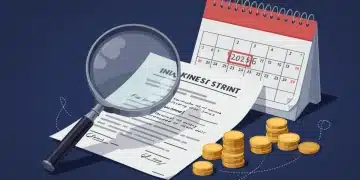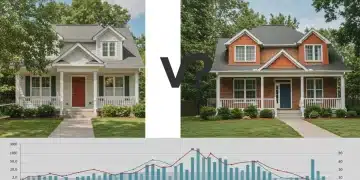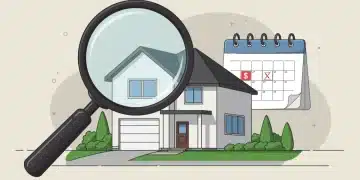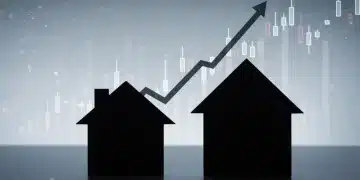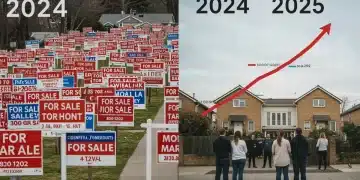Understanding Closing Costs 2025: Expect 2% to 5% of Loan
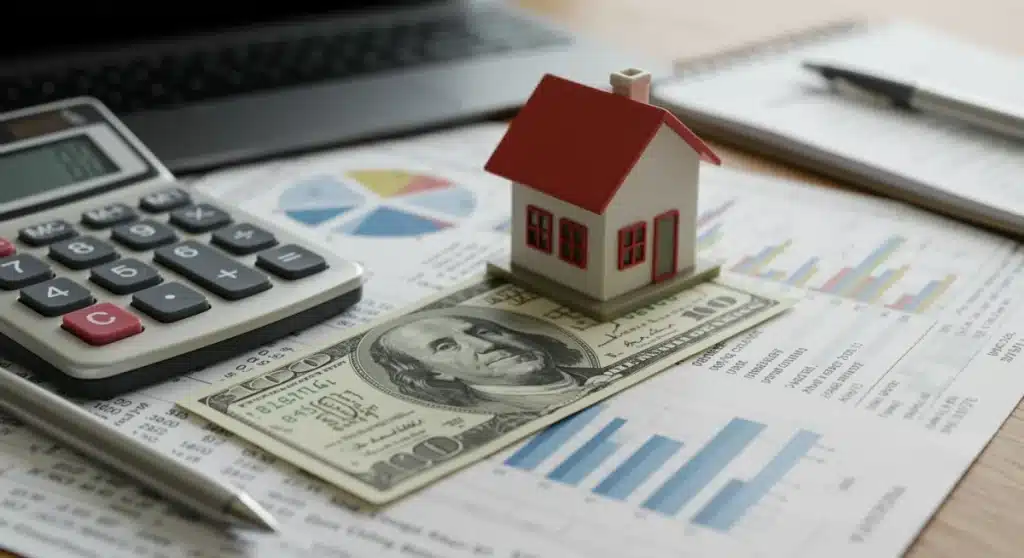
Understanding Closing Costs 2025: Expect to Pay 2% to 5% of Your Loan Amount is critical for prospective homebuyers, as these significant expenses directly impact overall affordability and financial planning for real estate transactions.
As the real estate market gears up for 2025, prospective homebuyers are urged to focus on a critical financial component: Understanding Closing Costs 2025: Expect to Pay 2% to 5% of Your Loan Amount. This often-overlooked expense can significantly impact your overall budget, making early preparation essential for a smooth transaction.
What Are Closing Costs and Why They Matter
Closing costs encompass a range of fees and charges paid at the closing of a real estate transaction. These are distinct from the down payment and represent the administrative and legal expenses associated with transferring property ownership and securing a mortgage. For 2025, experts continue to project these costs will typically fall within the 2% to 5% range of the total loan amount, a figure that can translate into tens of thousands of dollars.
These costs are not static; they vary based on location, loan type, and the specific services required for the transaction. Understanding each component is vital for buyers to avoid last-minute financial surprises. The aggregate of these fees covers services provided by various entities involved in the home-buying process, from lenders to title companies and government agencies.
Key Components of Closing Costs
Several categories contribute to the total closing cost figure. Being aware of these can help buyers budget more effectively and potentially negotiate certain fees. These components reflect the intricate process of transferring property and securing financing.
- Lender Fees: Charges by the mortgage lender for processing the loan, including origination fees, underwriting fees, and discount points.
- Title and Escrow Fees: Costs associated with title search, title insurance, and the escrow services that facilitate the closing process.
- Government Recording Fees: Fees paid to local government to record the new deed and mortgage.
- Appraisal and Inspection Fees: Payments for professional assessments of the property’s value and condition.
Projected Range for 2025: 2% to 5% Explained
The projection of 2% to 5% of the loan amount for closing costs in 2025 is a critical benchmark for homebuyers. This range is not arbitrary; it accounts for the multitude of services and fees involved in a typical real estate transaction. For a $300,000 loan, this means an additional $6,000 to $15,000 in upfront costs beyond the down payment, a substantial sum that requires careful financial planning.
This percentage can fluctuate based on several factors, including the state in which the property is located, the complexity of the transaction, and the specific lender chosen. High-cost states often see closing costs at the higher end of this spectrum, while more competitive markets might offer slightly lower rates. Buyers should always obtain a detailed loan estimate to understand their specific obligations.
Factors Influencing the Percentage
Understanding the variables that push closing costs towards either end of the 2% to 5% spectrum is crucial. These factors are interconnected and can significantly impact a buyer’s total out-of-pocket expenses at closing.
- Geographic Location: Different states and even counties have varying taxes and recording fees.
- Loan Type: FHA, VA, and conventional loans can have different fee structures and requirements.
- Lender and Service Providers: Fees for origination, title services, and appraisals can differ between providers.
- Property Taxes and Insurance: Often, several months of property taxes and homeowner’s insurance premiums are collected at closing to establish an escrow account.
Breaking Down the Major Cost Categories
To effectively budget for Understanding Closing Costs 2025: Expect to Pay 2% to 5% of Your Loan Amount, it’s essential to dissect the various categories that comprise these expenses. Each category serves a distinct purpose in ensuring a legal and secure property transfer, and understanding them empowers buyers to ask informed questions and potentially negotiate. These categories broadly fall into lender-related, third-party services, and government charges.
Lender fees are often among the largest components of closing costs. These are charges levied by the mortgage company for originating and processing your loan. They are typically disclosed upfront in the loan estimate.
Lender fees are often among the largest components of closing costs. These are charges levied by the mortgage company for originating and processing your loan. They are typically disclosed upfront in the loan estimate.
Detailed Look at Lender Fees
Lender fees are often among the largest components of closing costs. These are charges levied by the mortgage company for originating and processing your loan. They are typically disclosed upfront in the loan estimate.
- Loan Origination Fee: A charge for processing the loan application, typically 0.5% to 1% of the loan amount.
- Underwriting Fee: Covers the cost of evaluating and approving your loan.
- Discount Points: Optional fees paid to the lender to reduce the interest rate on the mortgage.
Strategies for Managing and Reducing Closing Costs
While Understanding Closing Costs 2025: Expect to Pay 2% to 5% of Your Loan Amount is a given, there are proactive strategies homebuyers can employ to manage and potentially reduce these significant expenses. Being informed and strategic can save thousands of dollars at closing. The key lies in diligent research, negotiation, and careful selection of service providers.
Many closing costs are negotiable, and comparing offers from different lenders and service providers can yield substantial savings. Additionally, some government programs and seller concessions can alleviate the financial burden. Initiating these discussions early in the home-buying process is crucial.
Negotiating with Sellers and Lenders
One of the most effective ways to reduce closing costs is through negotiation. Sellers, especially in a buyer’s market, might be willing to contribute towards closing costs to facilitate the sale. Lenders, too, can sometimes adjust their fees.
- Seller Concessions: Requesting the seller to pay a portion of your closing costs can significantly lower your out-of-pocket expense.
- Lender Shopping: Compare Loan Estimates from multiple lenders to find the best rates and lowest fees.
- Negotiating Fees: Some lender fees, like origination or underwriting fees, might be negotiable.
The Role of Location and Loan Type in 2025
The geographical location of the property and the specific type of mortgage loan secured play significant roles in determining the final figure for Understanding Closing Costs 2025: Expect to Pay 2% to 5% of Your Loan Amount. These variables introduce a layer of complexity, as different regions and loan products come with their own unique sets of regulations, taxes, and associated fees. Buyers must consider these factors early in their home search.
States with higher property transfer taxes or specific local fees will naturally push closing costs towards the upper end of the projected range. Similarly, certain loan programs, while offering benefits like lower down payments, might have distinct upfront costs that buyers need to be aware of. Researching state-specific requirements is paramount.

State-Specific Variations
Each state has its own fee structure for real estate transactions, which can significantly impact total closing costs. These variations are often due to different tax laws, recording fees, and local ordinances.
- Transfer Taxes: Some states impose significant transfer taxes on property sales, which can be paid by either the buyer or seller, depending on local custom or negotiation.
- Attorney Fees: In some states, it’s mandatory for an attorney to be present at closing, adding to the legal costs.
- Escrow Fees: The cost of escrow services can vary by region and the complexity of the transaction.
Preparing for Your Closing Costs in 2025
Effective preparation is the cornerstone of a successful home purchase, especially when it comes to Understanding Closing Costs 2025: Expect to Pay 2% to 5% of Your Loan Amount. Prospective buyers should start planning for these expenses well in advance of making an offer. This involves not only saving the necessary funds but also actively engaging with lenders and real estate professionals to gain a clear picture of what to expect.
Early engagement with a lender to obtain a detailed Loan Estimate is a crucial first step. This document provides a comprehensive breakdown of all anticipated costs, allowing buyers to compare offers and prepare financially. Moreover, maintaining a healthy credit score and stable financial history can also influence the types of fees and rates offered.
Essential Steps for Buyers
Taking proactive steps will ensure that you are financially ready for closing. These actions can help you anticipate and manage costs, reducing stress during the final stages of your home purchase.
- Obtain a Loan Estimate: Request this document from multiple lenders to compare fees and interest rates.
- Review Your Closing Disclosure: Three days before closing, you will receive a Closing Disclosure, which details all final costs. Review it carefully for any discrepancies.
- Save Adequately: Beyond your down payment, ensure you have sufficient funds saved to cover the 2% to 5% projection for closing costs.
- Ask Questions: Do not hesitate to ask your lender, real estate agent, or attorney about any fees you don’t understand.
| Key Point | Brief Description |
|---|---|
| Cost Range | Closing costs in 2025 are projected to be 2% to 5% of the loan amount. |
| Key Categories | Includes lender fees, title/escrow fees, government fees, and appraisal/inspection costs. |
| Cost Influencers | Location, loan type, and specific service providers significantly impact total costs. |
| Management Strategies | Negotiate with sellers/lenders, shop for providers, and review Loan Estimates carefully. |
Frequently Asked Questions About 2025 Closing Costs
For 2025, homebuyers should anticipate closing costs to be between 2% and 5% of their total loan amount. This percentage covers various fees associated with the mortgage and property transfer, varying by location and loan specifics.
Yes, some closing costs are negotiable. Buyers can often negotiate certain lender fees, and sellers might agree to contribute towards closing costs, especially in a buyer’s market. Comparison shopping for service providers is also recommended.
A Loan Estimate is a document provided by lenders detailing all estimated loan terms and closing costs. It’s crucial for comparing offers from different lenders and understanding the financial obligations before committing to a mortgage.
No, closing costs are separate from the down payment. The down payment is a portion of the home’s purchase price paid upfront, while closing costs are additional fees for services and taxes related to securing the loan and transferring ownership.
Location significantly impacts closing costs due to varying state and local taxes, recording fees, and legal requirements. Some states have higher property transfer taxes or mandate attorney involvement, increasing overall expenses for buyers.
Looking Ahead: What This Means for 2025 Homebuyers
The consistent projection of 2% to 5% of the loan amount for closing costs in 2025 signals that these expenses will remain a substantial financial hurdle for homebuyers. This data underscores the ongoing need for meticulous financial planning and due diligence. As interest rates and housing prices continue to fluctuate, the stability of this closing cost range provides a clear target for budgeting. Prospective buyers should leverage this information to engage proactively with lenders and real estate agents, ensuring they fully comprehend and prepare for all associated costs. Expect further market updates to refine these projections, but the core message remains: prepare for significant upfront expenses beyond the down payment.
